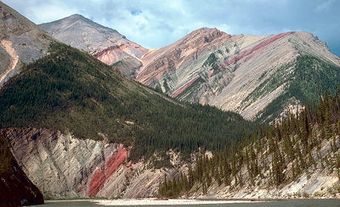Wood Mountain, elev 1000 m, is located about 135 km southwest of Moose Jaw, Sask, near the Forty-Ninth Parallel. It is underlain by sedimentary rocks that were not eroded by downcutting rivers because of their position between drainage systems. Flat-topped hills, dissected by coulees, rise some 400 m above the surrounding prairie. Métis settled on the slopes of Montagne de bois in 1870, building houses from the plentiful poplar trees. In 1871 the HBC trading post at Wood Mountain became the prairie depot of the Boundary Commission. Use of the area by whisky runners and horse thieves prompted the NWMP to purchase the depot in 1876 and maintain a post until 1918. Over 5000 Dakota Sioux and their leader, Sitting Bull, took refuge in this area after the Battle of the Little Bighorn in 1876. A provincial historic park was established in 1965. The only known sources of helium in Canada exist around Wood Mountain and Swift Current.
-
- MLA 8TH EDITION
- Sauchyn, David. "Wood Mountain". The Canadian Encyclopedia, 23 July 2014, Historica Canada. www.thecanadianencyclopedia.ca/en/article/wood-mountain. Accessed 25 April 2024.
- Copy
-
- APA 6TH EDITION
- Sauchyn, D. (2014). Wood Mountain. In The Canadian Encyclopedia. Retrieved from https://www.thecanadianencyclopedia.ca/en/article/wood-mountain
- Copy
-
- CHICAGO 17TH EDITION
- Sauchyn, David. "Wood Mountain." The Canadian Encyclopedia. Historica Canada. Article published February 07, 2006; Last Edited July 23, 2014.
- Copy
-
- TURABIAN 8TH EDITION
- The Canadian Encyclopedia, s.v. "Wood Mountain," by David Sauchyn, Accessed April 25, 2024, https://www.thecanadianencyclopedia.ca/en/article/wood-mountain
- Copy
Thank you for your submission
Our team will be reviewing your submission
and get back to you with any further questions.
Thanks for contributing to The Canadian Encyclopedia.
CloseArticle
Wood Mountain
Article by David Sauchyn
Published Online February 7, 2006
Last Edited July 23, 2014

 Share on Facebook
Share on Facebook Share on X
Share on X Share by Email
Share by Email Share on Google Classroom
Share on Google Classroom


